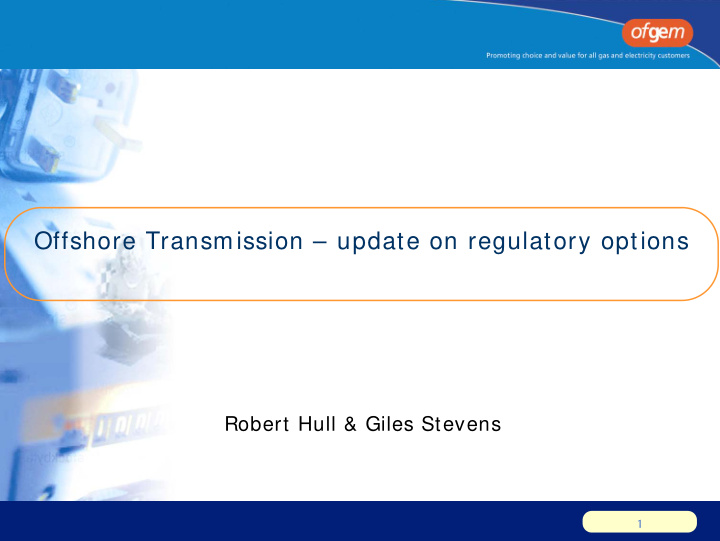



Offshore Transmission – update on regulatory options Robert Hull & Giles Stevens 1
Contents � Background: aim of project � Re-cap of initial options � Our current thinking � Way forward 2
Background: aim of project � To institute a regulatory framework and design price controls � Powers derive from Energy Act � New area of “network” regulation 3
Background: existing and planned generation sites 4
5 Background: the REZ
Background: particular characteristics � Radial connections (largely) with no demand customers � No existing regime/ incumbents/ infrastructure � 100% load related capex investment 6
OFFSHORE TRANSMISSION REGIME Options for implementing the price control regime Options for implementation – July OTEG 1. Extension of Onshore Arrangements to adjacent areas The current 3 TO onshore zones are extended offshore - in practice this results in a single TO (National Grid) actually operating offshore (for Round 1 and 2), although future Rounds for wind or wave and tidal are likely to result in the other TOs starting operations. 2. Single Offshore Zone (1 TO) A competitive tender is held for a single offshore zone, awarded to one TO (in perpetuity). 3. 3-5 Zones (competitive tender) Between 3 and 5 zones are established within the Strategic Areas and a competitive tender is held for a TO licence in respect of each zone (resulting in between1 and 5 TOs). 4. 3-5 Bundles of Lines (competitive tender) A competitive tender is held for 3-5 ‘bundles’ of generating stations located in close proximity to each other (resulting in between 1 and 5 TOs). 5. Distribution Model - many TOs A number of TO licences are granted (using existing applications route) for a single offshore zone, developers then (jointly or individually) hold a competitive tender amongst licensed TOs to supply their grid connection. 6. Point to Point - many TOs Developers hold a competitive tender to prospective TOs to supply the grid connection, the winner then approaches Ofgem for a TO licence via application. 7
Our current thinking � Moving from theory to reality � Led to two broad approaches: 1. Exclusive: 2. Non-exclusive: � Focus to develop workable option for each approach � Difficult problem – no natural fit � Used onshore as basis of the two approaches � Aim is to get approaches refined enough so we can consult on two tangible options 8
Exclusive licences � Single TO would be exclusively responsible for a defined geographic area � Number of ways this could be done – ultimately a somewhat arbitrary approach � Suggest competitively tendered regional monopoly zones � Has potential element of competition � Multi-zones allows possible benchmarking � Discretion in future award of licences in other areas 9
Conceptually – exclusive licences Pay TNUoS Charges TOCO Incumbent Users Ofgem GBSO TO Offer Terms 10
Conceptually – non-exclusive licences Pay TNUoS Charges TO1 TOCO TO2 Users Ofgem GBSO TO3 Etc. Offer Terms 11
Non-exclusive licences - changes � TO licenses issued to any party which applies and meets the application criteria � After application from generator, all offshore TOs have the right to submit a TOCO � Bids can be for single / multiple applications � TOs bid revenue stream � Winning TO gets price control � Impact: – Generators: minimal change – TOs: must bid for work – Customers: share risk, share reward 12
Promoting choice and value for all gas and electricity customers 13
Recommend
More recommend